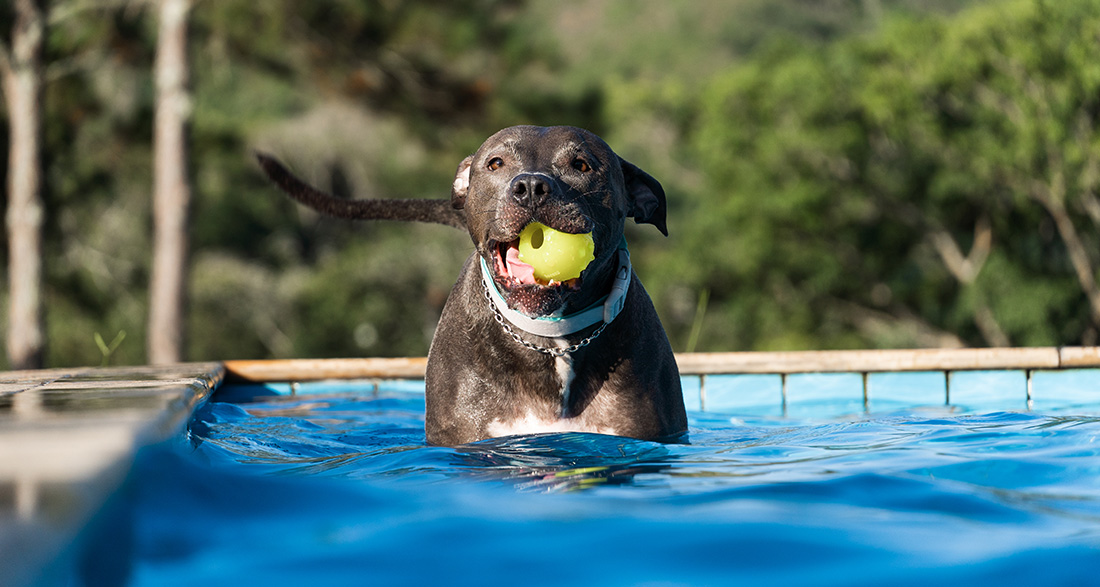A pool is a fantastic way to relax during the summer, but you should be aware of how chlorinated water can affect your dog. In this article, you’ll learn more about the effects of chlorinated water on your dog and get essential tips to ensure the safety of your pet.
- The dangers of drowning and pool safety measures for dogs
- Special Precautions for Puppies and Older Dogs in the Pool
- Precautions for Swimming in Chlorinated Water
- The Effects of Chlorine on the Dog’s Skin and Paws
- The Role of Chlorine in Water Disinfection and Potential Risks
- Alternatives to Chlorinated Pool Cleaning for Dog Care
- Dos and Don’ts – Behavioral Tips for Dogs in the Pool
- Frequently Asked Questions
During the warm months, it’s tempting to bring your dog into the pool to provide them with cooling and fun. However, it’s crucial to be aware of the potential dangers of chlorinated water for dogs and take appropriate precautions.
Chlorine is a chemical component used in many pools for disinfection to inhibit the growth of algae and other microorganisms. In small amounts, chlorine is harmless to humans and dogs, but a high concentration can lead to allergic reactions, gastrointestinal issues, and skin irritations. These negative effects can be severe, especially for sensitive dogs or puppies.
To minimize the danger, it’s advisable to shower your dog before swimming in chlorinated water to avoid potential skin irritations. After bathing, rinse your dog with clean water to remove any chemical residues.
In general, dogs should never swim or splash in the pool unsupervised, as they can quickly become fatigued or get into distress. Especially for puppies and older dogs, ensuring safety is crucial, and they should never be left alone in the pool.
It’s also important to monitor the temperature of the pool water. Sudden temperature changes can be dangerous for dogs and lead to circulatory collapse. It’s recommended to keep the water lukewarm or slightly cool and gradually acclimate the dog to it.
In addition to the effects on the skin and circulation, make sure your dog doesn’t drink chlorinated water. Excessive chlorine consumption can cause gastrointestinal issues and, in the worst case, health problems. Ensure your dog always has access to fresh, clean water and refrain from letting them lick themselves during pool baths.
There are also alternatives to chlorine-based pool cleaning that are more suitable for dog care. Sand filter systems, natural water preservatives, and regular removal of leaves or debris can keep the water clean without using large amounts of chlorine.
If you want to allow your dog to swim, consider special dog pools or other safe water options. These provide a secure environment for your dog and minimize the risk of injuries or health problems.
To ensure your dog’s safety in the pool, consider some essential tips. Make sure the pool has a secure entry and exit point, and always keep an eye on your dog. Avoid overexerting your dog or letting them stay in the water for too long.
The dangers of drowning and pool safety measures for dogs
Ensuring safe entry and exit into the swimming pool is crucial to prevent the risk of drowning for your dog. Dogs are not naturally good swimmers and can quickly get into trouble. Therefore, special safety measures in the pool area are essential to ensure the safety of your pet. Here are some important steps you can take:
- Provide safe access to the pool: Ensure your dog has an easy and secure way to enter the swimming pool. A sturdy pool ladder or a special dog ladder can help. Avoid steep edges or smooth surfaces that could facilitate slipping.
- Monitor your dog while swimming: Never let your dog swim in the pool unsupervised. Even if your dog is a good swimmer, they can get into trouble or become exhausted. Always keep a watchful eye on the dog and be ready to assist if needed.
- Teach your dog to swim: Not all dogs are naturally good swimmers. Take the time to teach your dog to swim and gradually build their confidence in the water. Start with shallow water and help your dog get used to the movements and sensations in the water.
- Use flotation aids: If you are unsure whether your dog can swim safely, you can put a life jacket or other flotation aids on them. These can provide your dog with additional buoyancy and help them stay in the water.
- Regularly check the pH and chlorine levels of the pool water: Improperly adjusted pH or excessive chlorine levels in pool water can cause skin irritations and health problems for your dog. Ensure that the pool water is well-balanced and use appropriate pool chemicals if necessary.
Your dog’s safety in the pool is a top priority. By taking these safety precautions and keeping a close eye on your dog, you can help them feel safe and comfortable while swimming in chlorinated water.
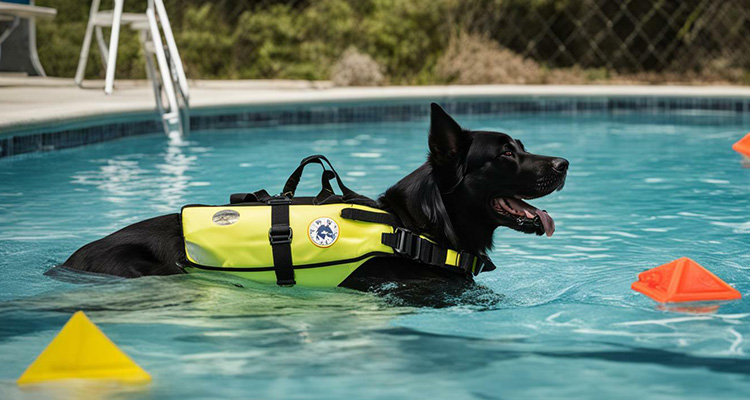
Special Precautions for Puppies and Older Dogs in the Pool
Especially puppies and older dogs should never swim unsupervised in the pool, as they may not assess the dangers properly. It’s crucial to take special precautions to ensure their safety.
Puppies in the Pool:
Puppies are curious and adventurous, so you must be particularly careful when letting them swim in the pool. Here are some essential tips for the safety of puppies in the pool:
- Choose a dog pool or a shallow basin specifically designed for small dogs. Ensure that your puppy can comfortably stand and move freely.
- Make sure your puppy can swim before letting them into deep water. Start with shallow water and gradually let them go deeper to get used to swimming.
- Never leave your puppy unsupervised in the pool. Always keep a vigilant eye on them to identify potential dangers and intervene immediately.
- Teach your puppy how to safely exit the pool. Practice exiting through the pool stairs or a special ramp together.
- Ensure your puppy doesn’t get too exhausted. Puppies do not have the same endurance as adult dogs and can tire quickly. Let them rest regularly, and monitor their body language for signs of exhaustion.
Older Dogs in the Pool:
Older dogs may also have special needs when it comes to swimming in the pool. Here are some tips to ensure the safety of older dogs in the pool:
- Choose a pool or basin with a shallow entry and non-slip surfaces to facilitate entry and exit for older dogs.
- Avoid taking older dogs into deep water if they have difficulty swimming or moving confidently in the water. Offer them shallow water where they can stand and cool off.
- Never leave older dogs unsupervised in the pool. Keep an eye on them and watch for signs of exhaustion or discomfort.
- Encourage older dogs to swim slowly and carefully to avoid injuries or overexertion.
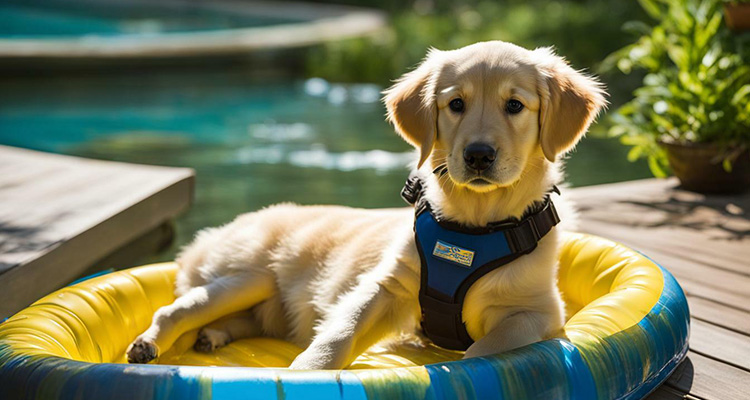
Remember that every dog is unique and has different needs. Observe your dog closely and adjust your precautions accordingly to ensure their safety and well-being.
Precautions for Swimming in Chlorinated Water
For higher temperatures and dogs with health problems, special precautions should be taken to avoid potential negative effects of chlorinated water. Heat and health problems can pose a danger for dogs swimming in chlorine pools.
When temperatures rise, ensure your dog doesn’t overheat. Dogs have a limited ability to regulate their body temperature and are susceptible to heatstroke or heat collapse.
Some dogs may have health issues that can make swimming in chlorinated water risky. For instance, dogs with skin problems may react sensitively to chlorine, leading to skin irritations or allergies. It’s crucial to consider your dog’s individual needs and health conditions before letting them into the water.
To minimize the effects of heat and health issues while swimming in chlorinated water, take the following precautions:
- Ensure your dog drinks enough water and stays hydrated. With higher temperatures, the body loses more fluid, so it’s essential for your dog to drink enough to stay hydrated. Provide access to fresh water to quench their thirst.
- Monitor your dog for signs of overheating, such as heavy panting, trembling, exhaustion, or weakness. If you notice these signs, bring your dog to a cool place and provide access to cold water to cool them down.
- Avoid going into the pool with your dog on extremely hot days. Dogs struggle to regulate their body temperature when external temperatures are very high. It’s better to stay in the shade on such days and provide your dog with other cooling options.
- Protect your dog’s skin and paws from the effects of chlorinated water by rinsing them off with tap water before swimming and thoroughly drying them after swimming. This helps remove excess chlorine and protects the dog’s skin.
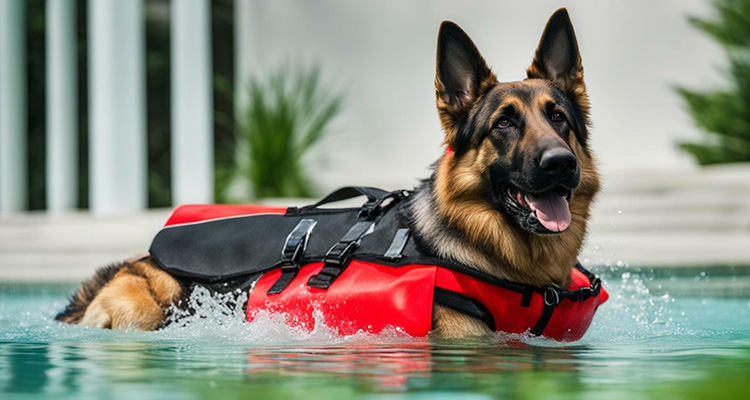
The Effects of Chlorine on the Dog’s Skin and Paws
Chlorine can cause skin irritations and paw problems in dogs, so it’s essential to use appropriate care products. Especially for dogs that regularly swim in chlorinated water, special care products suitable for contact with chlorinated water should be used.
The dog’s skin is sensitive and can be irritated by the chlorine in the water. It can lead to dryness, redness, and itching. To avoid this, rinse your dog with clear water after swimming in the pool and then wash them with a chlorine-resistant dog shampoo. This helps remove the chlorine from the skin and preserves the natural moisture balance of the skin.
Another crucial area that can be affected by chlorine is the dog’s paws. While swimming in the pool, chemicals can accumulate on the paws and cause irritations. To prevent this, apply special, chlorine-resistant paw cream or balm to your dog’s paws before they go into the water. These protect the paws from drying out and prevent cracks or injuries.
Tips for Skin and Paw Care in Chlorinated Water:
- Rinse your dog thoroughly with clear water after swimming in the pool to remove chlorine.
- Use a chlorine-resistant dog shampoo to clean and care for your dog’s skin.
- Apply special paw cream or balm before swimming to protect your dog’s paws.
- Regularly check your dog’s skin and paws for possible irritations or injuries and treat them accordingly.
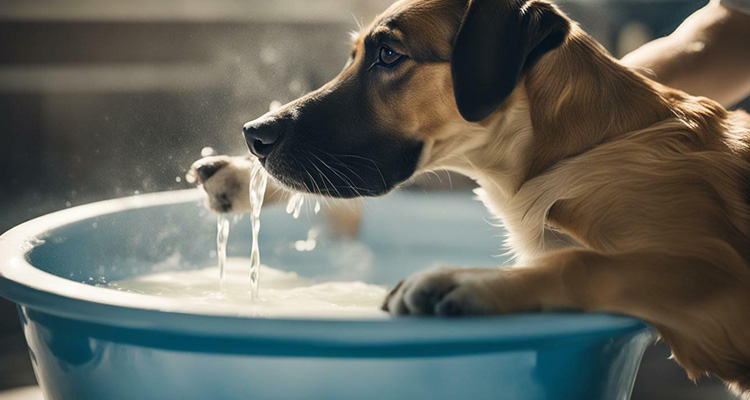
It is essential to keep an eye on your dog’s skin and paws and take immediate action if problems arise. If your dog shows signs of skin irritations or paw issues, consult a veterinarian to determine the best treatment method.
By paying attention to the care of your dog’s skin and paws in chlorinated water, you can ensure that your four-legged friend stays healthy and happy while enjoying the pool.
The Role of Chlorine in Water Disinfection and Potential Risks
Chlorine is used for water disinfection, but it poses certain risks for dogs that should be examined closely. Water disinfection is crucial to prevent the spread of pathogens and microorganisms. Chlorine is a chemical component capable of killing these harmful organisms and keeping the water clean. It is used in both swimming pools and drinking water to ensure a safe environment.
Although chlorine in small amounts is generally safe for dogs, high concentrations can lead to health issues. Excessive contact with chlorinated water can cause allergic reactions such as skin irritations, itching, and redness. It can also result in gastrointestinal problems like diarrhea and vomiting.
Dogs have more sensitive skin than humans, making them more susceptible to the negative effects of chlorine. Therefore, it is crucial to monitor how long a dog is exposed to chlorinated water and the concentration of chlorine in the water. Excessive exposure to chlorine on the skin can lead to dryness and irritations. Some dogs may also be allergic to chlorine, developing eczema-like symptoms.
It’s important to note that not only swimming in the pool but also drinking chlorinated water poses dangers for dogs. If a dog drinks water treated with chlorine from a pool, it can lead to stomach problems. Therefore, it’s advisable to always provide clean drinking water for your dog and ensure they do not drink from the pool.
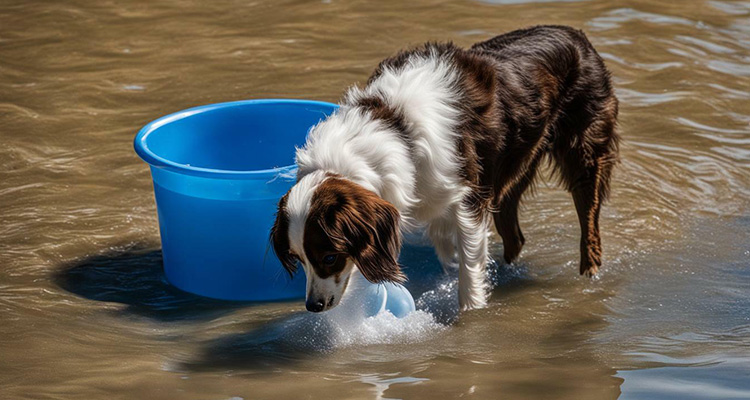
Using low-chlorine or chlorine-free water in the pool can be an alternative to minimize potential risks of chlorine for dogs. There are also other water disinfection methods using less chlorine, such as salt electrolysis systems. These systems convert salt in the water into active chlorine through electrolysis, ensuring hygienic water quality without the use of high chlorine concentrations.
When caring for dogs in chlorinated water, it’s important to watch for potential symptoms of an allergic reaction or other health issues. If a dog shows signs of discomfort, such as itching, rash, diarrhea, or vomiting, a veterinarian should be consulted.
| Effects of Chlorine on Dogs | Precautions |
|---|---|
| Allergic reactions such as skin irritations, itching, and redness | Minimize exposure to chlorinated water, use low-chlorine or chlorine-free water |
| Gastrointestinal problems like diarrhea and vomiting | Avoid dog from drinking chlorinated water, provide clean drinking water |
| Dry skin and irritations | Limit time in chlorinated water, care for the skin after swimming with moisturizing products |
| Eczema-like symptoms in allergic reaction to chlorine | Conduct allergy tests, avoid chlorinated water |
Using low-chlorine water, limiting time in the pool, and caring for the skin after swimming are crucial measures to minimize potential risks of chlorine for dogs. It is important to keep the dog’s needs and well-being in mind and consult a veterinarian if there are concerns.
Alternatives to Chlorinated Pool Cleaning for Dog Care
There are alternatives to chlorinated pool cleaning that are less harmful to dog care. Chlorine can cause health problems for dogs, especially if they drink pool water or spend extended periods swimming in it. Fortunately, there are other ways to keep the water clean and safe without using chlorine.
One option is the use of salt electrolysis systems. These systems utilize a chlorine electrolysis process to disinfect the water. The salt in the water is converted into active chlorine through electrolysis, which kills bacteria, microorganisms, and pathogens. The significant advantage of salt electrolysis is that the water is low in chlorine and does not cause allergic reactions or other health problems for your dog. It is also more skin-friendly for you as a pool owner. Another benefit is that the pool water remains crystal clear without the typical smell of chlorine.
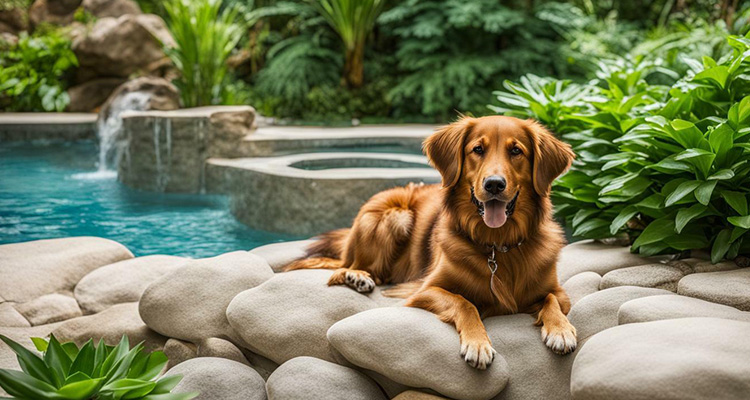
Another alternative is the use of active oxygen. Active oxygen is an environmentally friendly alternative to chlorine, disinfecting pool water and killing germs. It is gentler on the skin and less irritating to the eyes and respiratory system. Active oxygen can be added to pool water in the form of tablets or granules, keeping the water clean and clear.
Another approach is the use of natural water care products. Various natural substances, such as enzymes or biological cleansers, can clean and disinfect pool water. These products are safe for both humans and animals and can be used without concerns.
It’s important to note that even when using alternative methods for pool cleaning, regular maintenance and monitoring of pool water are necessary. The pH level and water quality should be checked regularly and adjusted if needed to ensure that the water remains clean and safe.
Overall, these alternatives to chlorinated pool cleaning provide a gentler and more health-friendly option for dog care in the pool. They allow you to let your dog swim safely without exposing them to the harmful effects of chlorine. Choose the method that best suits you and your dog, and enjoy quality time in the pool without worrying about your beloved pet’s health.
Dos and Don’ts – Behavioral Tips for Dogs in the Pool
There are certain behavioral rules that dogs should follow in the pool to keep everyone safe and stress-free. Here are some dos and don’ts to keep in mind:
Dos
- Always supervise your dog while swimming in the pool. Do not leave them unsupervised in the water.
- Ensure that your dog can enter and exit the pool safely. A pool staircase or a dog pool ramp can help with that.
- Give your dog regular breaks while swimming to avoid exhaustion.
- Rinse your dog with clean tap water after swimming in the pool to remove any chlorine residues.
Don’ts
- Let your dog swim in chlorinated water for too long. Excessive chlorinated water exposure can irritate their skin and paws.
- Allow your dog to drink from the pool. Chlorinated water is not healthy for dogs and can cause stomach problems.
Frequently Asked Questions
Is chlorinated water dangerous for dogs?
Chlorinated water can be dangerous for dogs, especially if they drink large amounts of it. It can cause allergic reactions, diarrhea, and vomiting. However, an optimal dosage of chlorine in pool water is generally considered safe.
How can I protect my dog from the effects of chlorine?
You can protect your dog from the effects of chlorine by ensuring they do not drink too much pool water. After swimming, rinse them with clean water to remove chlorine residues from their skin.
What precautions should I take when my dog swims in the pool?
It is important never to leave your dog unsupervised in the pool. Ensure they have a safe entry and exit and monitor their behavior in the pool. Remember that not all dogs are good swimmers, especially puppies and older dogs.
Are there alternatives to chlorine-based pool cleaning?
Yes, there are alternatives to chlorine-based pool cleaning that are better suited for dog care. One option is the use of salt electrolysis systems, which disinfect pool water with active chlorine but are less irritating to the skin and eyes.
What are safer water options for dogs?
A safe water option for dogs is a specialized dog pool that allows them to swim. A kiddie pool with regular tap water can also be a good option as long as it does not contain any chemical additives.
What are the key tips for the safety of dogs in the pool?
The key tips for the safety of dogs in the pool are: always supervise your dog in the water, ensure they have a safe entry and exit, and avoid leaving them unsupervised in the pool. Protect their skin from chlorine by rinsing them before swimming.
What are the dos and don’ts when dealing with dogs in the pool?
When dealing with dogs in the pool, make sure they do not drink too much pool water and do not keep their paws in the water for too long. Avoid leaving the dog unsupervised in the pool, and ensure they have a safe entry and exit.
What are the benefits of safe and hygienic pool care for dogs?
Safe and hygienic pool care offers the benefit of allowing your dog to swim in the pool without health risks. Clean pool water and the avoidance of excessive chlorine protect their skin and contribute to their well-being.
How important is safety and care for my dog in the pool?
The safety and care of your dog in the pool are crucial to minimize potential dangers and ensure their well-being. Take the time to implement necessary precautions and provide appropriate care for your dog.


